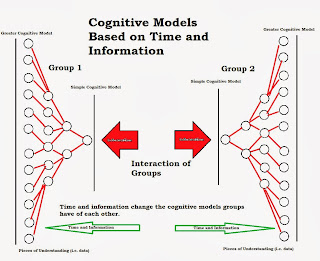Workplace communication and cross-culture
interaction can help foster greater levels of collaborative effort. A paper by
Huber & Lews (2011) highlights how heuristics and bias are a platform for
first understanding others but additional information creates stronger cognitive
models. It is these models within groups or across groups that adjust
overtime to create mutual development.
When individuals understand each other’s cognitive
models they create cross-understanding (Huber & Lewis, 2010).
Cross-understanding can also occur on a group level whereby a cognitive model
for a group and their vantage point has been developed. Knowing how your
communication partners think and understand can be beneficial for relating
information in a way in which it is palatable and creating shared
understandings.
Shared understandings range from low to high in
terms of their accuracy and quantity of information. Some may know very little
about other groups while some may have a great deal of experience. This is a
level of shared social theory or shared social understanding. This is generally
based in familiarity, cross-communication, and reflection. Even members within
the same group may have different understandings of others even though they
have shared similar traits.
People come
to understand others through default templates that are full of assumptions. As
they interact with others, communicate, share experiences, and see how others
act in certain situations they come to update those templates. It is a process
of offering new information based within real life experience.
Conflict is often caused by misunderstandings or
unreasonable behavior. The more groups interact and share relevant information
the better the decisions of the group. This process can only work if members
are free to talk, share ideas, and brainstorm the possibilities. Group think
occurs when individuals are not free to communicate leading to one sided
vantage points and strategies.
Over compliance to group norms, assumptions and
rules creates 1.) a lack of new information, and 2.) poorer overall decisions
that limit cross understanding. Group
assumptions based on heuristics create faster reactions but also limit the
potential to be accurate in decision-making. Quick assumptions are regularly
faulty as they are confined by a lack of available information.
The paper brings forward concepts that may be useful
to businesses that are either in the process of developing stronger teams or
would like to reduce encampment within their ranks. People often choose to work
with others that are similar to themselves. Each brings forward their own
cognitive model based with quick heuristic platforms. As they interact with
each other it broadens their ability to understand the other. When these
cognitive platforms are different than other members of the same group there is
pressure overtime to solidify them into shared conscious understandings (i.e.
the stream of conscious).
Huber, G. & Lewis, K. (2011).
Cross-understanding and shared social theories. Academy of Management Review, 36 (2).
Huber, G. P., & Lewis, K.
2010. Cross-understanding: Implications for group cognition and performance. Academy of Management Review, 35:
6–26.
